How to Decide Which Galapagos Islands to Visit?
A vacation to the Galapagos Islands is a huge tick for any travel bucket list. It’s like stepping into your very own Discovery Channel documentary.
Yet, Galapagos trip planning can be confusing. With 13 main islands, and over 40 smaller islets, how is one to decide which Galapagos Island to visit?
Unless you have an unlimited budget and weeks of time to play with, it’s not going to be possible to visit all of the islands. So, compromises will need to be made.
Each and every Galapagos Island has something unique to offer. While some excel at wildlife diversity, others have smoldering volcanoes and great landscapes to enjoy.
Some Galapagos Islands can only be reached aboard a Galapagos Cruise, while others are easy day tour destinations from inhabited islands.
Decisions during Galapagos trip planning will define your whole trip and are therefore not to be taken lightly.
Keep reading for our expert advice and guidance to help decide which Galapagos Island to visit. We’ll break the discussion down into bite-sized sections, including the best islands for wildlife, landscapes, diving, beaches, accommodation, and airport access.
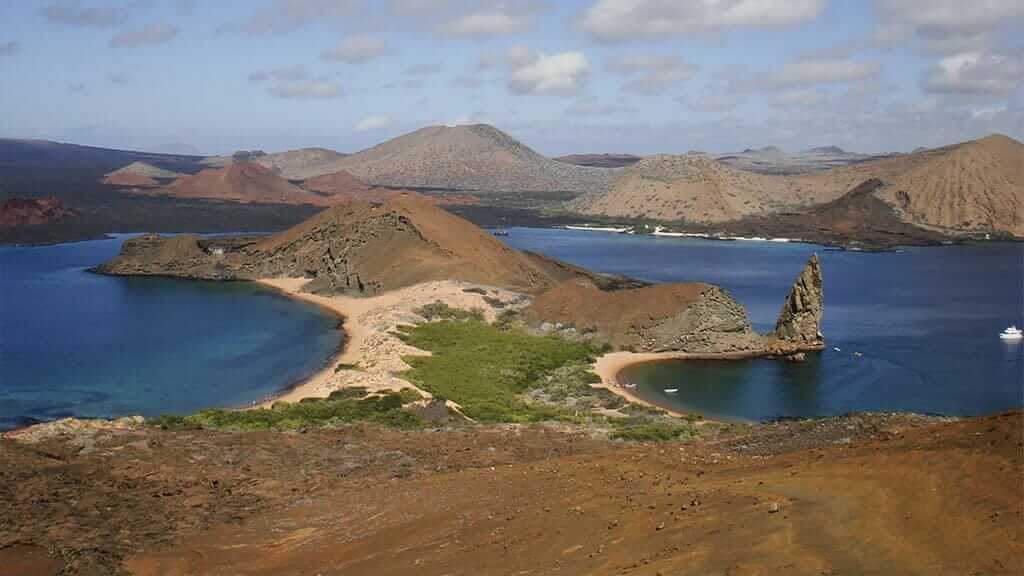
Where is Galapagos?
Before we dive in, let's zoom out for some context.
Where are the Galapagos Islands?
How many Galapagos islands are there in total?
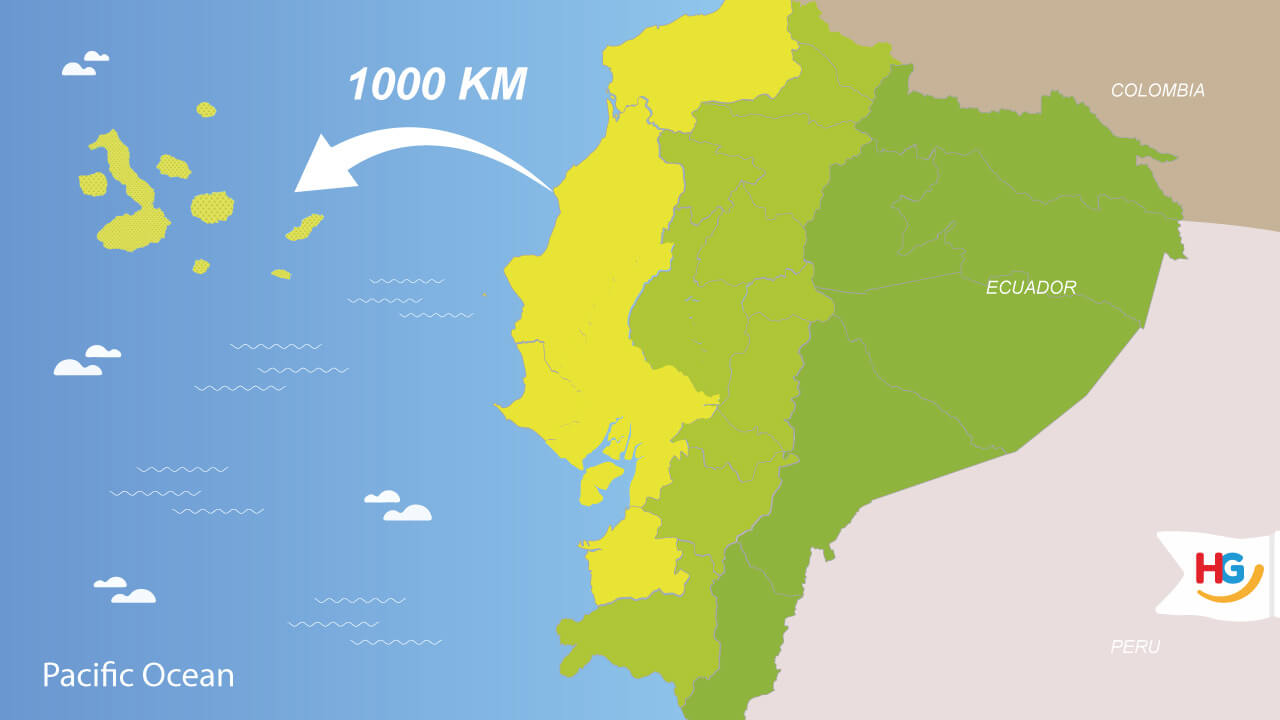
The Galapagos Islands are located in the Pacific Ocean, approximately 1000 kilometers (600 miles) from the west coast of South America. Ecuador is the closest country to the Galapagos archipelago and is also the sovereign owner of the islands.
Due to the remote location, there's only one way for visitors to get to Galapagos, and that's to fly. Daily departures take off from the cities of Quito and Guayaquil.
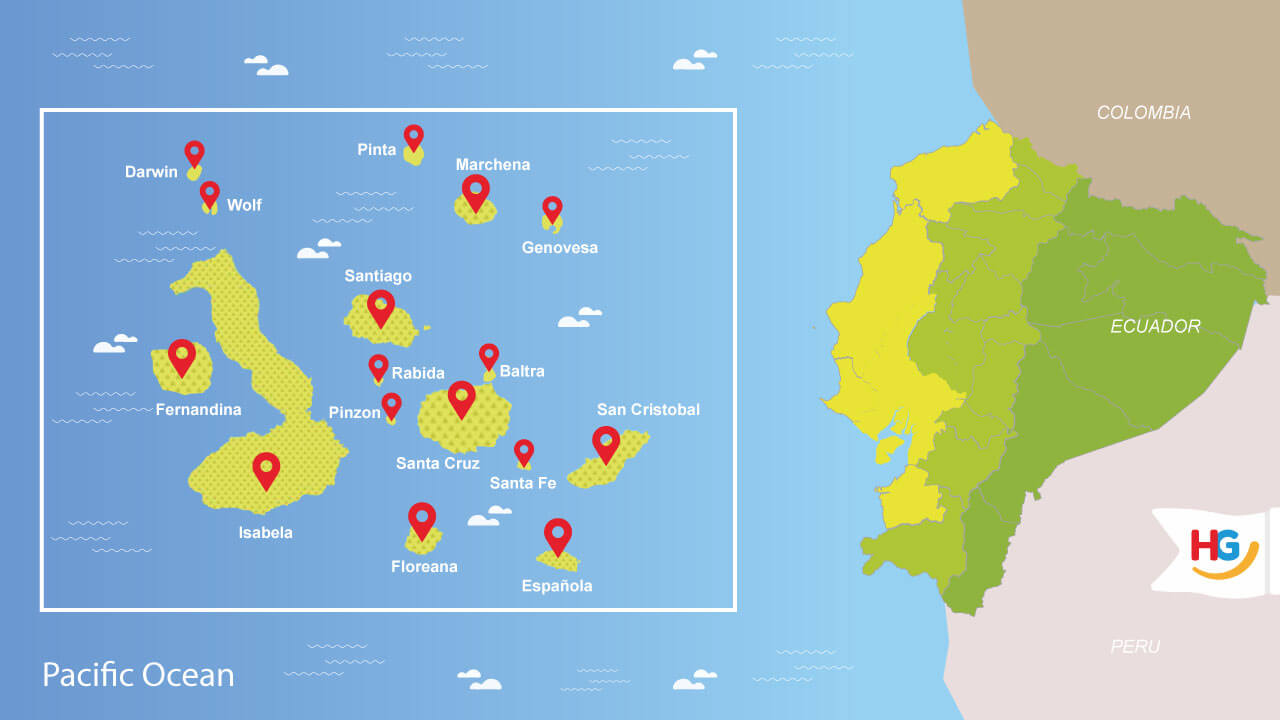
How Many Galapagos Islands Are There? The archipelago consists of 13 major islands, over 40 smaller islands, and many more rocky outcrops. Check out our interactive Galapagos Map for a detailed view.
However, unless you have several weeks of vacation time and a large budget to play with, it won’t be possible to visit all of the islands in one single trip.
Most visitors, therefore, choose to compromise and visit just some of the islands. But how to make the tough decision of which Galapagos islands to visit, and which to skip?
It’s make-or-break time for your Galapagos vacation trip planning.
So, let's get some advice from the Galapagos experts. Which Galapagos Islands should make the cut, and why?
Best Galapagos Islands for Wildlife
The #1 reason that most tourists visit the Galapagos Islands is to discover the amazing bucket-list wildlife there.
Many of the birds and animals are endemic, meaning that they can only be found in the Galapagos Islands. But each island is different, and some Galapagos creatures can only be spotted at specific places.
So, which Galapagos Islands are best overall for wildlife? Here are our top 4 recommendations.
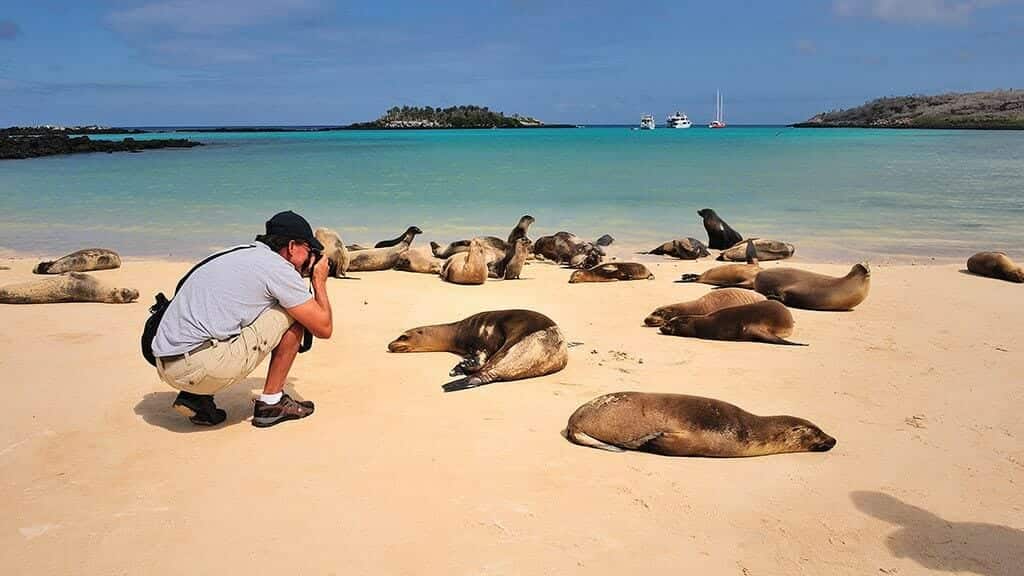
1. Española Island
My favorite overall Galapagos Island for wildlife is Española, to the southeast of the archipelago. Here, the sheer volume of birds and animals will blow most visitors away.
Playful Galapagos sea lions swim around your approaching boat, while Sally Lightfoot crabs and Marine Iguanas cling to the black lava rocks. You'll also encounter one of the largest blue-footed booby colonies in the Galapagos. These amusing birds are the clowns of the islands – if you are lucky enough to see their funny mating dance then you’ll understand why. Nasca boobies also nest here.
Meanwhile, Española’s best wildlife highlight awaits further up on the clifftop. Española Island is the only nesting site on the planet for the endemic Galapagos Waved Albatross. From April to December each year, albatross couples congregate here to mate and rear their fluffy white chicks.
Española Island can be visited as part of a cruise itinerary, or as a day tour from San Cristobal Island.
2. Fernandina Island
To the far west of the Galapagos archipelago, Fernandina Island is another top spot for Galapagos wildlife watching.
The big pull of the western Galapagos islands is to cross paths with two remarkable marine birds, the Galapagos Penguin, and Flightless Cormorant. Their nesting sites line the coasts of Fernandina and Isabela Island (west coast only), making this the best place in the Galapagos to find them all year round.
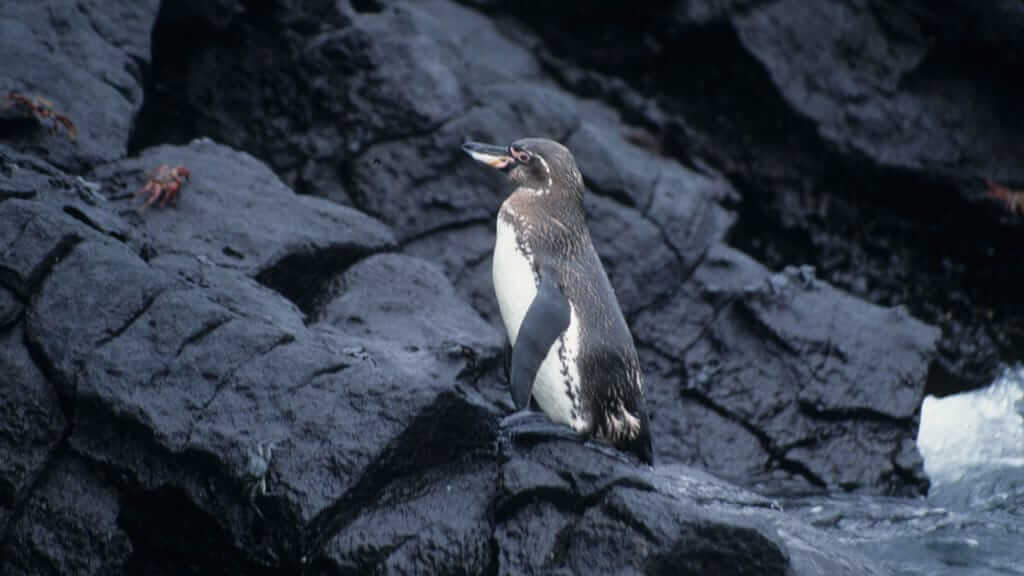
Fernandina is also home to the largest colony of marine iguanas in the archipelago, as well as Galapagos Fur Seals.
From July to October / November each year, in the cold waters of the Bolivar channel between these two islands, it’s also the prime spot for Galapagos whale-watching and dolphin spotting.
Fernandina Island & the west coast of Isabela can only be visited on a live-aboard Galapagos cruise.
3. Genovesa Island
Genovesa Island in Galapagos is known as the bird island, and for good reason.
The nesting Red Footed Boobies are a treat. These are the hardest to find of all the Galapagos boobies, hanging out on just a few select islands. Genovesa Island boasts the largest colony on the planet.
Visitors will also find a Swallow-Tailed Gull colony. This is the only nocturnal gull species in the world, that uses night vision to hunt.
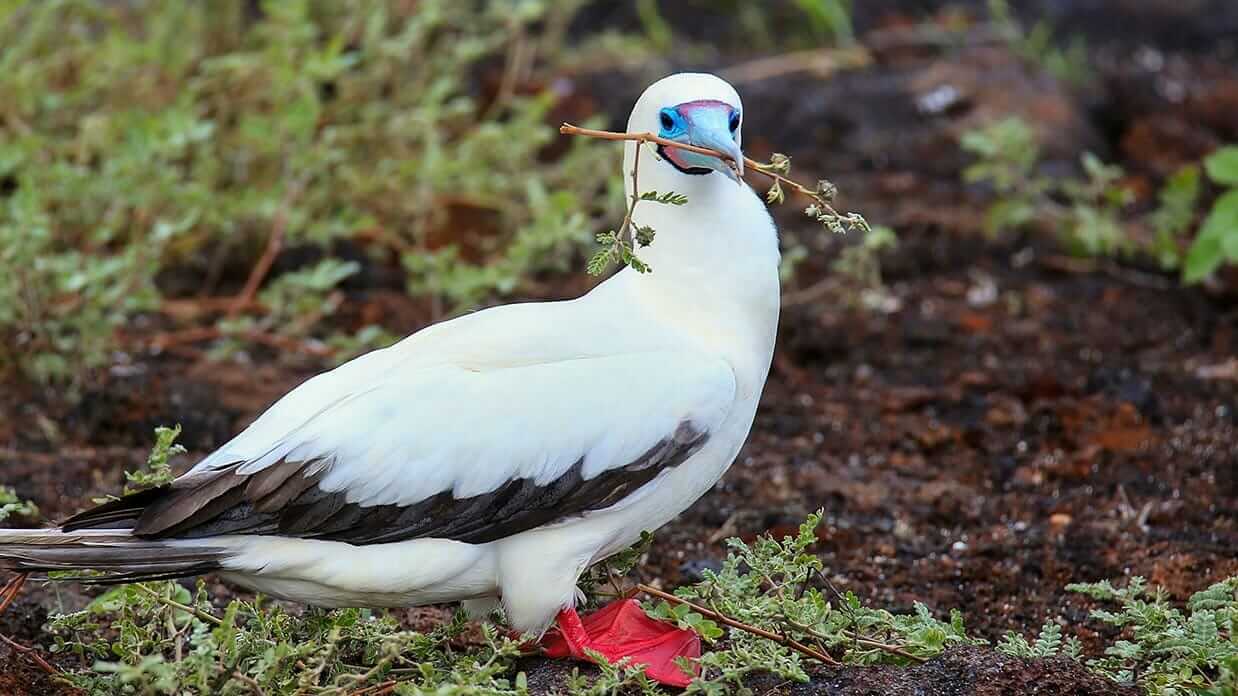
Up on the island highlands, petrels swarm the sky in great numbers, while the Galapagos Short-Eared Owl camouflages perfectly against the brown lava terrain.
Genovesa Island is located far to the north of the Galapagos Archipelago, so can only be visited as part of a Galapagos cruise itinerary.
4. North Seymour Island
Our final choice for the best Galapagos Island for wildlife is North Seymour.
North Seymour’s inclusion is justified as a great allrounder. This one small island packs a powerful punch in terms of Galapagos wildlife favorites.
Both Magnificent and Great Frigate Birds nest in the bushes, inflating their red pouches to attract a female mate (the best month for this spectacle is June). There’s also a Blue-Footed Booby colony along the walking trail.
On land, try to spot golden-colored Galapagos Land Iguanas lounging under Opuntia Cactus plants.
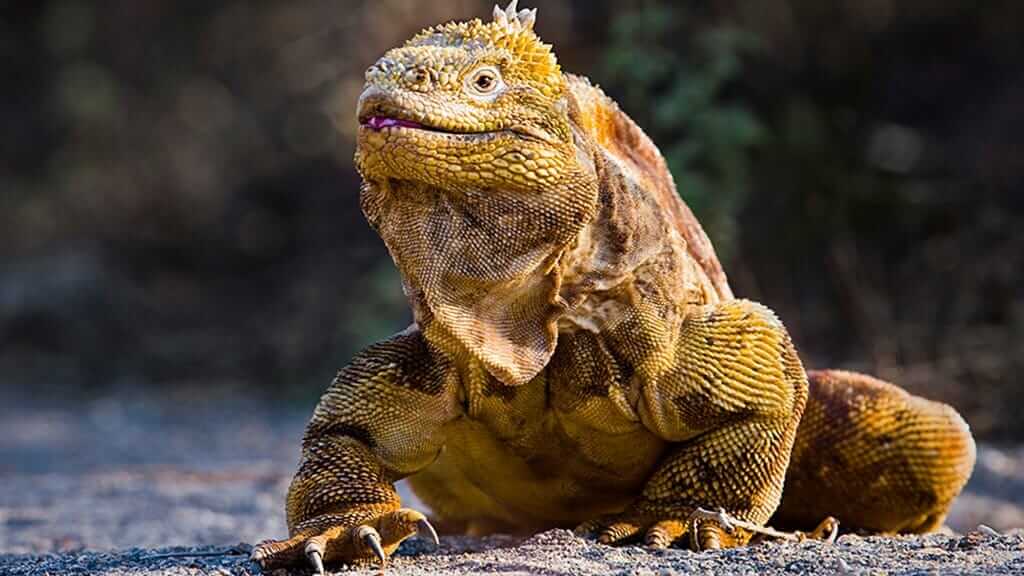
Galapagos sea lions are also very active in the sea along the coast of this island.
North Seymour Island also gets a gold star for accessibility. It’s easy to visit as a day tour, part of a Galapagos Land Tour itinerary, or aboard a cruise yacht.
You might be wondering, what about the iconic Galapagos Giant Tortoise, where can I see them? It’s actually very easy to find them on any of the main inhabited islands, up on the highlands (for example El Chato Reserve), or at breeding centers.

Bear in mind that some islands may be the only spot to find a specific Galapagos bird or animal that you really want to see. In this case, it's important to chat with our expert sales team or refer to our specific animal blog posts to know where to find them. We'll always do our best to ensure that specific wildlife requests are catered for.
Which Galapagos Islands are Best for Landscapes?
The Galapagos Islands are not just about weird and wonderful creatures. It’s also a great destination to enjoy spectacular scenery and one of the most volcanically active zones on the planet.
Here are our top 3 islands for Galapagos volcanoes and photogenic landscapes.

1. Bartolome Island
Bartolome is the most photographed island in Galapagos, and it’s easy to see why.
The stunning 360-degree panoramic viewpoint at Bartolome Island is a mix of vivid black & red lava, green vegetation, deep blue sea, and golden sand, all contrasting together beautifully. At the center is Pinnacle Rock, an unusual, natural rock formation emerging from the land like an arrowhead.
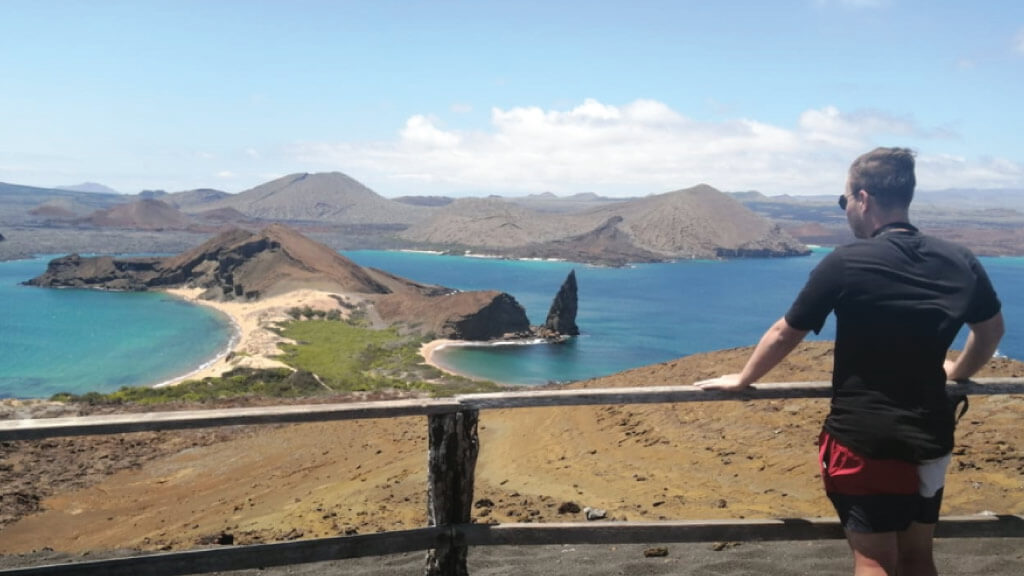
If you only take one happy family snap together at the Galapagos islands, it surely has to be here!
Like North Seymour, Bartolome is easy to visit on a day tour, Galapagos Land Tour, or aboard a cruising yacht.
2. Santiago Island
Visitors to Santiago Island find themselves in a world of surreal black, basalt lava flows, and unusual textures. It’s perfect for unusual photos to impress your friends on social media.
Santiago’s outstanding geological feature is the huge basaltic lava flow at Sullivan Bay. This is the largest and longest lava flow in the Galapagos Islands! Visitors are allowed to walk on the lava to appreciate the swirls and patterns up close. The more observant among you might spot lava bubbles and petrified tree trunks.
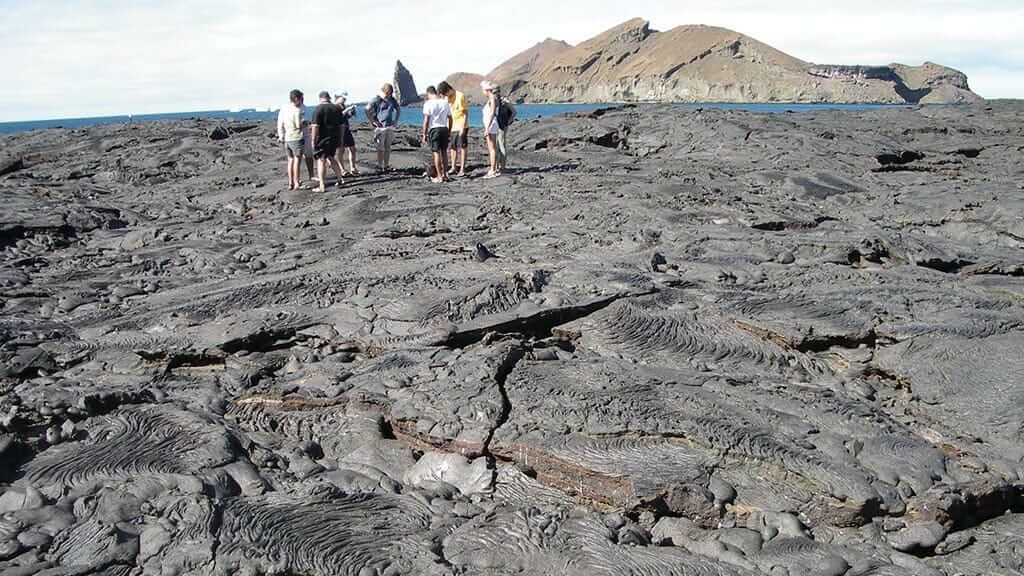
Surreal landscapes of black lava stretch out as far as the eye can see. These are wonderful examples of Pahoehoe lava flows. Pahoehoe is slow-moving lava with low viscosity, forming attractive ropey patterns when it solidifies.
Photographers in particular will find Santiago Galapagos ideal for taking abstract snaps of these unusual forms.
Santiago is best visited as part of a Galapagos cruise itinerary.
3. Isabela Island
Our final choice of which Galapagos Island to visit for spectacular landscapes is Isabela, the largest land mass on the whole archipelago.
Isabela Galapagos is home to no fewer than 6 different volcanoes – Alcedo, Cerro Azul, Darwin, Ecuador, Sierra Negra, and Wolf volcanoes. In fact, the island was formed by the merging of these wide, shield volcanoes and their historic lava flows.
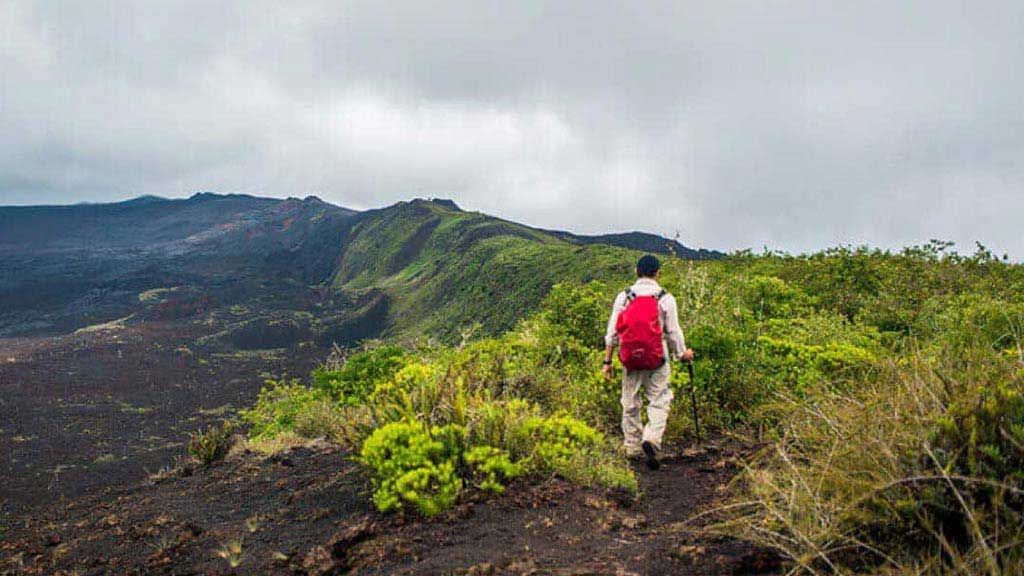
Located close to the Galapagos volcanic hotspot, all of these volcanoes are still active. So, once in a while, Galapagos tourists get to enjoy a spectacular eruption of lava, from a safe distance of course.
The best way to enjoy the volcanic landscape of Isabela Island is to cruise the Bolivar Channel, with unforgettable views along the way.
Best Galapagos Islands for beaches
The Galapagos Islands are home to some fabulous stretches of sand and surf, so tourists get an unexpected beach vacation thrown in for good measure.
Which Galapagos Islands are best for beaches? Check out which islands make our top 3.
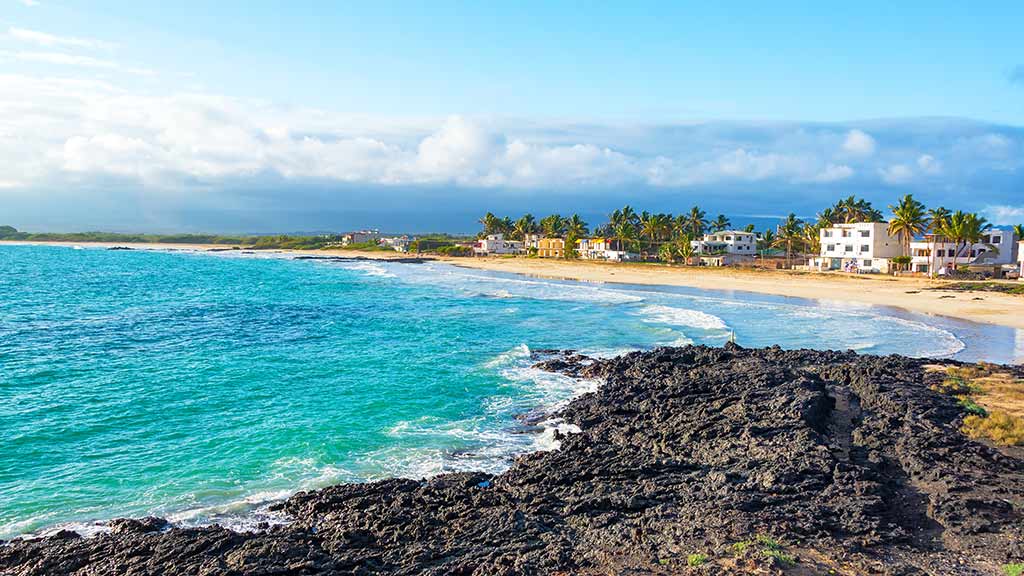
1. Española Island
Gardner Bay on Española is our top choice for the best Galapagos Islands beach.
Here visitors find a long stretch of pristine white sand and irresistible turquoise waters. It is certainly not hard to see why this Galapagos beach was voted among the top 20 beaches in the world by CNN (recently updated to the top 100).
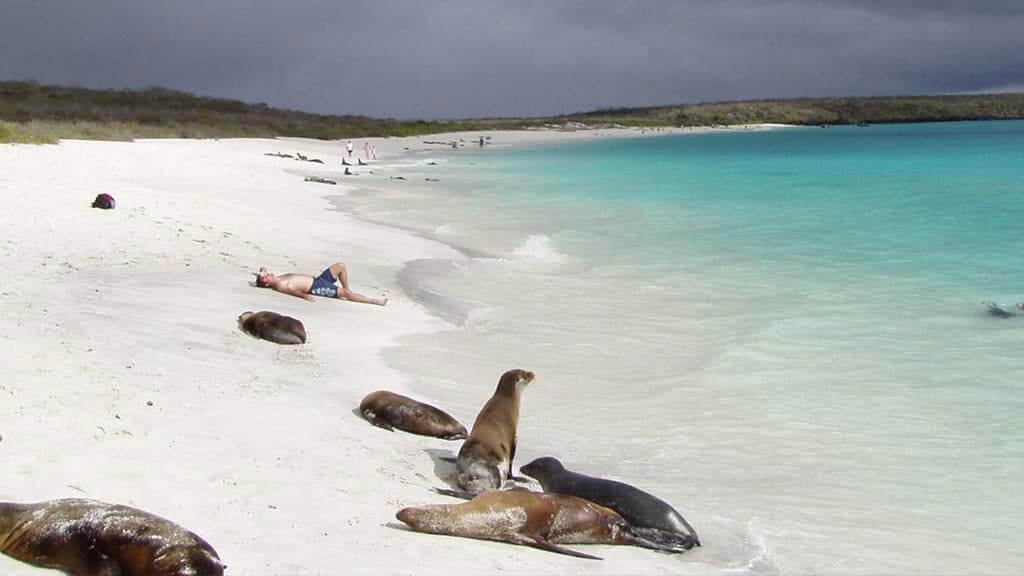
During cruise itineraries, Galapagos visitors can enjoy a couple of free hours here to relax and explore. It really is an idyllic spot. The highlight for most is the sleeping sea lions who dominate the white sands and happily pose for photos. The clear, shallow waters also make for great snorkeling or kayaking.
2. Rabida Island
For a more unusual beach head to the uninhabited island of Rabida, famed for its surreal red sand.
The unusual red sand color is caused by the iron-rich volcanic rocks found on Rabida Island. The rocks have been slowly ground down by the waves into smaller stones and red sand.
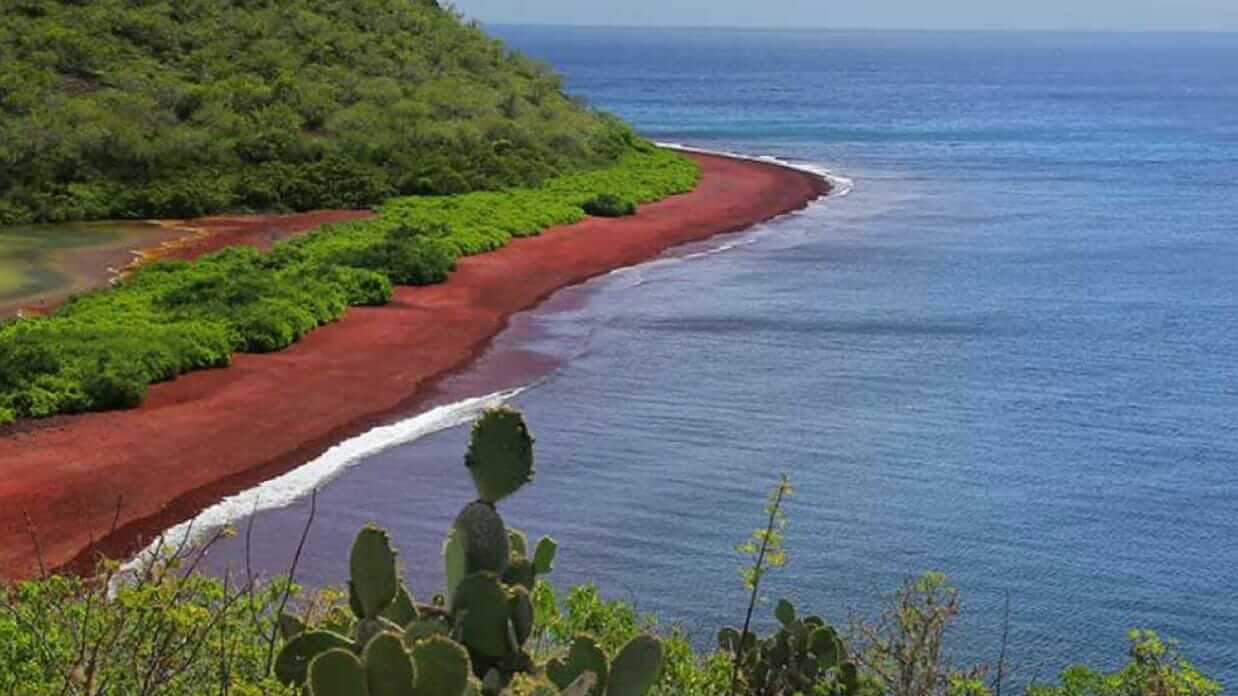
This Galapagos Islands beach is especially spectacular for photography. We recommend a visit in the early months of the year (January to April) when the red sand contrasts beautifully with the lush green mangroves.
Rabida Island is to the north of the archipelago, close to Santiago Island. To visit Red Beach, you’ll need to take a Galapagos Cruise and check that the itinerary includes a stop here.
3. San Cristobal Island
There is certainly a lot of competition among San Cristobal Island Galapagos beaches. From Playa Mann to La Loberia and Baquerizo Moreno beach visitors are spoiled for choice. But if we have to pick just one winner, we’ll opt for Punta Carola Beach.
Punta Carola is within walking distance of Puerto Baquerizo Moreno town. This spot is known locally as Lovers Beach, no doubt thanks to its romantic, secluded location.
This pretty sandy cove is certainly less trafficked than other beaches closer to town. Galapagos sea lions make friendly companions for those who make the short trek. Punta Carola is a great spot to kick back & unwind. The sunsets here are renowned for their beauty, and make the perfect end to an active day. For more adventurous types, hit the surf break off of Punta Carola rocks (not for beginners), or snorkel from the shore.
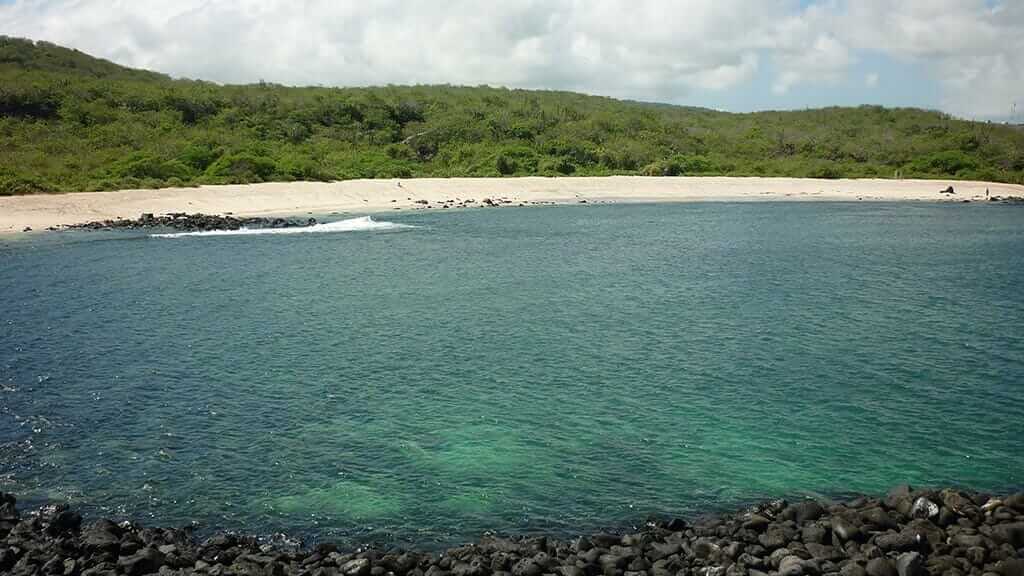
Punta Carola wildlife highlights include sea lions lazing along the beach, Marine Iguanas, Pelicans, and sometimes even sea turtles swimming up to the shore.
Other notable mentions for spectacular Galapagos sand include Tortuga Bay on Santa Cruz, and Puerto Villamil Beach on Isabela Island. Both are long, gorgeous, pristine stretches of white and golden sand and easy to visit by yourself without a tour guide.
Which Galapagos Island to Visit for Diving?
For world-class diving the Galapagos Islands also have you covered. But where is the best Galapagos scuba action to be found?
1. Darwin & Wolf Islands
Without question, Darwin and Wolf Islands are hands-down the VERY BEST dive islands in the Galapagos archipelago. These waters even boast the largest shark biomass of the world’s oceans.
What’s the catch? Darwin and Wolf are located a long way off to the very northwest of the Galapagos Archipelago. So, there’s only one way to visit – aboard a specialist, liveaboard Galapagos Dive Cruise.
Is it worth it? Hell yeah! The ocean around Wolf and Darwin Islands is visited by an unprecedented variety of marine creatures each year. Scalloped hammerheads, whale sharks, dolphins, rays, sea turtles, Galapagos sharks, and an overwhelming crowd of tropical fish hold court amidst the coral reefs and volcanic cliffs.
For experienced divers who are seriously passionate about their sport, Darwin and Wolf is THE place to scuba.
2. San Cristobal Island
For day divers, Kicker Rock on San Cristobal Island is hard to beat.
Sharks, rays, sea lions, and colorful fish just love hanging out at this eroded volcanic cone. Sometimes, hammerheads even cruise through.
The vertical, sheer rock walls emerging from the ocean also make for breathtaking photos, especially at sunset.
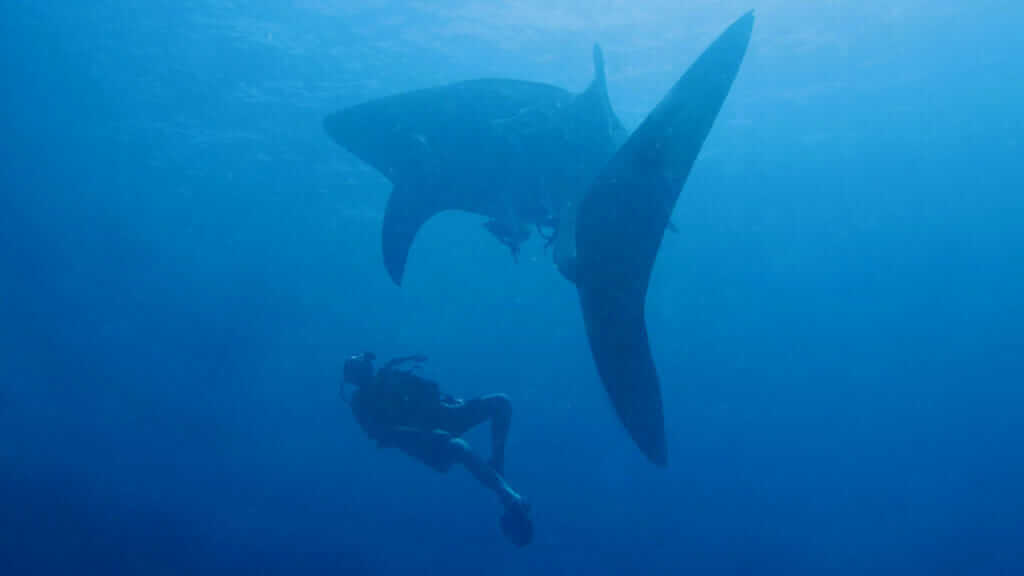
3. Santa Cruz Island
Day divers should also head to Santa Cruz Island. This is the perfect base to explore the underwater world of surrounding islets.
Gordon Rocks is famed among dive enthusiasts for great marine biodiversity, although the strong underwater currents make the site suitable only for experienced divers.
Other recommended dive sites from Santa Cruz include Beagle, Guy Fawkes, Cousins, and Santa Fe.
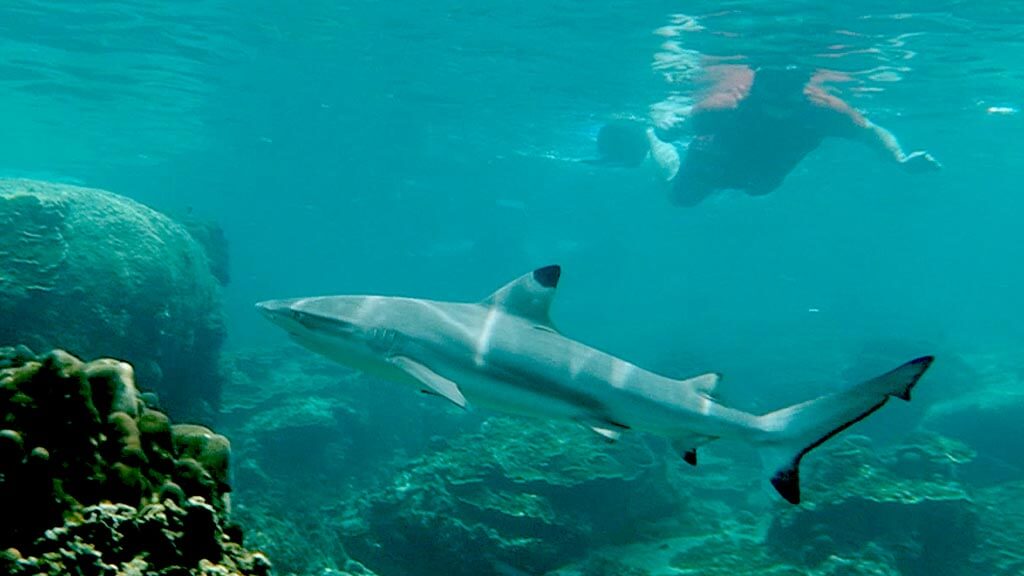
Which Galapagos Island to Stay on?
There are only 4 inhabited islands in the Galapagos, making our next list rather easy!
1. Santa Cruz Island
Starting at the top, Santa Cruz Island houses the largest Galapagos population and is the most popular island with tourists for an overnight stay.
Puerto Ayora is an attractive little port town with plenty to keep visitors busy on a free day or afternoon. As well as interesting visitor sites to spot wildlife or relax, Puerto Ayora boasts fine dining, boutique shopping, and an oceanfront boardwalk with great views to enjoy.

Santa Cruz also has comfortable overnight options, from Galapagos hotels to fancy resorts like Pikaia Lodge and Finch Bay Hotel.
The big draw of Santa Cruz Island is its central location and easy access to tours and activities.
2. San Cristobal Island
Next up comes laid-back San Cristobal Island.
Puerto Baquerizo Moreno town is a fun spot to mix and mingle, find a bite to eat, or grab a sundowner cocktail or beer. On top of that, some of the finest Galapagos beaches are to be found dotted along the San Cristobal coast - the perfect spots to surf, snorkel or relax a few hours away.
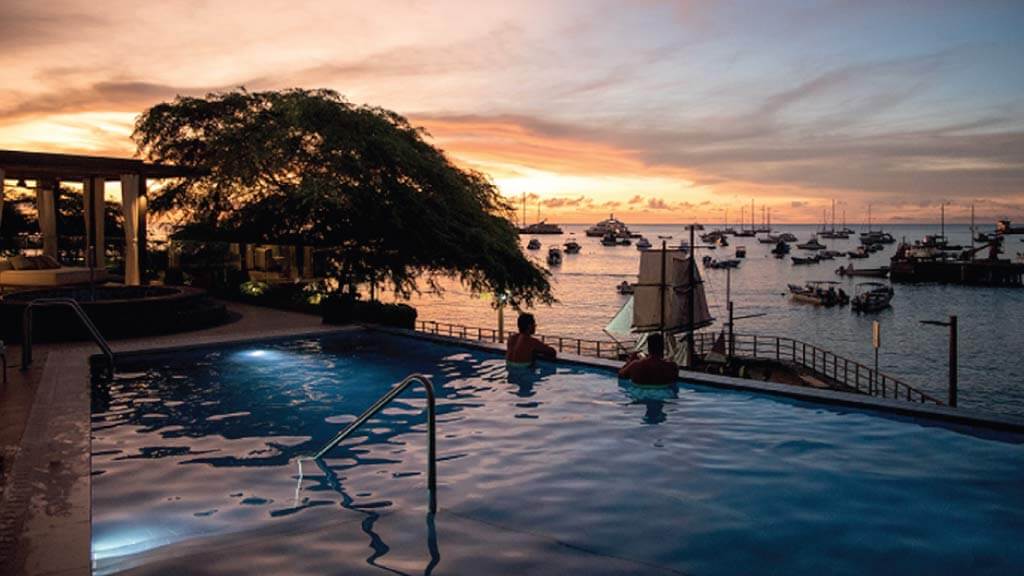
San Cristobal Galapagos hotels range from backpacker hostels right up to First Class luxury.
This might be the right spot if you enjoy free time to explore by yourself, and the flexibility to plan day by day once you are there.
3. Isabela Island
On Isabela Island the village of Puerto Villamil promises a slower pace and friendly locals that reel visitors in, providing a welcome break from full-on touring.
Right on the doorstep of your Isabela Island Hotel is a long, dreamy stretch of pristine white sand that is one of the very finest Galapagos beaches.
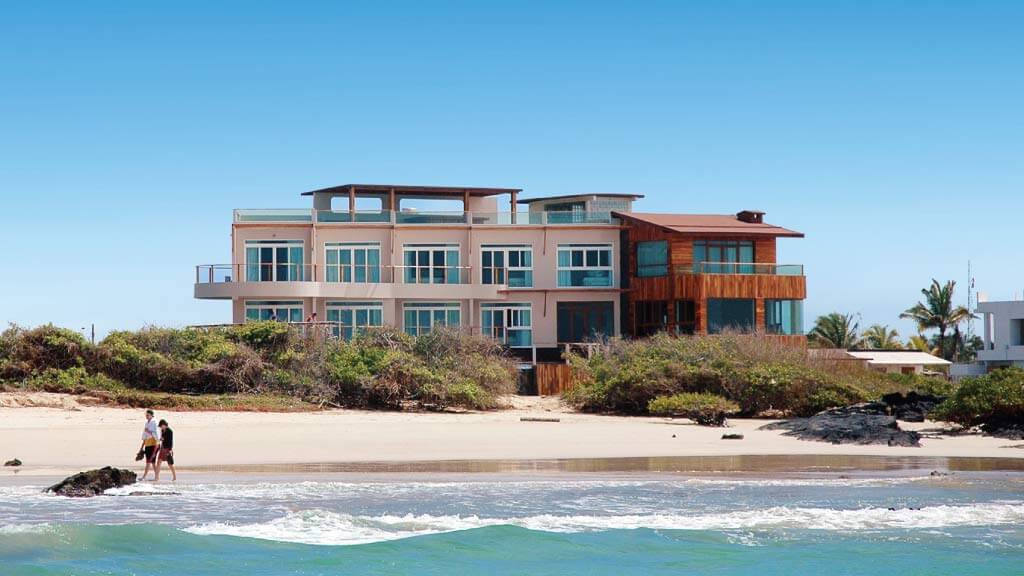
It’s also easy to organize fun tours, like hiking Sierra Negra Volcano, or snorkeling at Los Tuneles.
For the chance to kick back and relax amongst beautiful scenery, Isabela Island is the place to be.
4. Floreana Island
Last but not least comes the tiny community on Floreana Island.
Floreana boasts a fascinating human history of pirates, whalers, and intrepid early settlers. It was also where the events of the famous Galapagos Affair mystery took place. You can even visit one of the world's most unique post offices, where no stamps are required.
As one would expect, there are very few accommodation options on Floreana Island, and it’s tougher to get to, but the reward of freedom without many other tourists around is certainly enticing for some.
Still can’t decide? Why not consider Island hopping? Galapagos land tours stay on multiple inhabited islands, with visits to the best of the local sites, and transport between islands all included. This makes for an easy, diverse, and hassle-free Galapagos vacation. Check out Happy Gringo’s 8-day Galapagos Explorer itinerary, with overnight stays in Santa Cruz, San Cristobal, and Isabela.
Which Galapagos Island to Fly into?
The only way to get out to the Galapagos Islands is to fly. But which is the best Galapagos Islands Airport to fly into?
Although there are 3 different Galapagos Airports, visitors actually only have a choice of two to fly into from mainland Ecuador: Seymour Airport (GPS) on Baltra Island, and San Cristobal Airport (SCY) on San Cristobal Island. The third Galapagos airport, on Isabela Island, serves short-hop, intra-island flights only.
So, which Galapagos flight route to choose?
In general terms, Baltra Island is best for those seeking a central base from which to explore. Baltra is just a quick hop over to Santa Cruz Island, from where many Galapagos cruises & tours begin & end.
San Cristobal is a popular island for travel with freedom and flexibility. It’s easy to do your own thing here and experience a more relaxing vacation.
It’s also possible to fly into one Galapagos airport and out of the other. This is a neat way to see more of the islands with limited time.
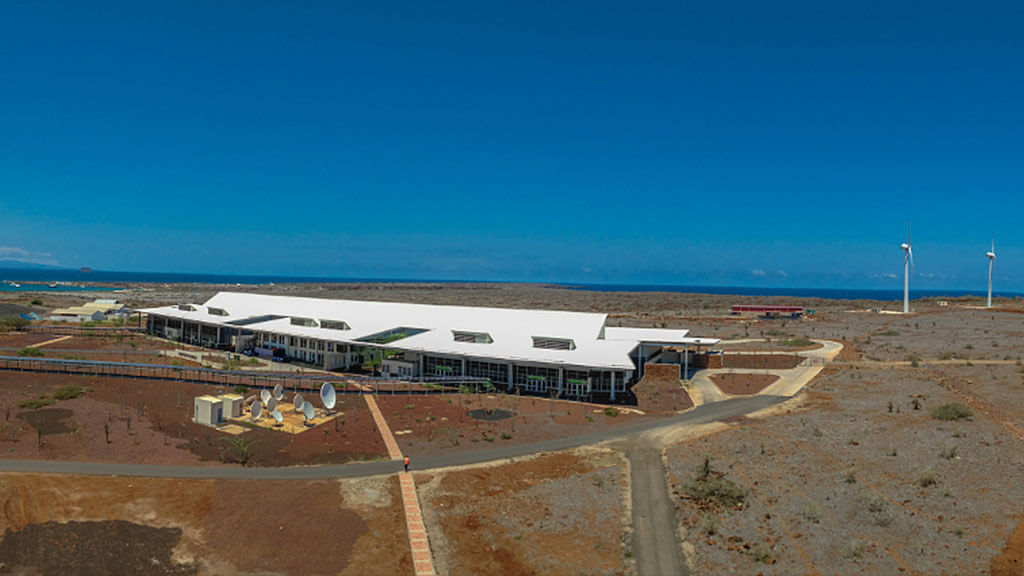
I hope this blog post has provided food for thought in your Galapagos Travel planning. For those who would like a helping hand or more advice, contact our expert team for a FREE GALAPAGOS TOUR QUOTE, we’ll be delighted to help!
In conclusion, which Galapagos Island is best? In truth, there is no one, correct answer. While some islands entice visitors with unique wildlife, others boast better scenery, infrastructure, or marine life.
For most tourists, it isn’t possible to visit all of the islands in the Galapagos in a single trip. Usually, one has to choose which general Galapagos region to explore, from the southeast, northern islands, or a cruise to the west.
No matter which Galapagos Islands you choose to explore, you won't be disappointed. The Galapagos Islands are a truly unique and unforgettable experience with memories that will last a lifetime.



